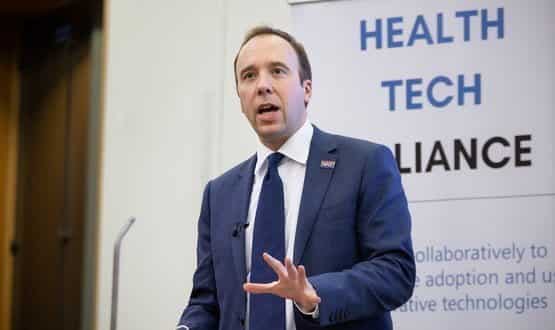NHS workforce needs tech innovation just as much as patients
- 18 February 2020

Upskilling the NHS workforce is a long-debated issue with the 2019 Topal Review concluding the health service should ‘focus on building digital workforce’. Rory Tanner from the Health Tech Alliance explores the issue following on from the inaugural Parliament & Healthtech Conference last month.
People are the most important part of healthtech innovation
Looking back on the Health Tech Alliance’s inaugural Parliament and Healthtech Conference on the 28 January, there is a quote from Dr Sam Roberts that has stayed with me: “Innovation is not just about the drugs or the technology, it’s about the translation of discovery into strategy”.
Dr Roberts is right. Although technology usually takes centre stage in any pioneering innovations, it is not the most important aspect of innovation. Indeed, the translation of discovery into strategy is not done by machine learning or AI, but by people.
People are fundamental to innovation. They are both the drivers of innovation and the recipients of its benefits. This means that at every stage of the innovation pathway, from the birth of an idea to its delivery, people should be at the heart of the process.
But this means more than people just being vaguely involved in the innovation pathway. It means that at every step, the consideration, consultation and collaboration with people needs to be the priority to help turn discovery into strategy. But the question is, what does this mean in practice?
Healthtech innovation requires patient trust
If the ultimate goal of healthcare innovation is to improve patient outcomes, then it is obvious that a key stakeholder in creating healthcare innovations is the patient. In the context of the healthtech industry, successful innovations require patients to feel comfortable with technologies, and more importantly, to trust these technologies.
One way to improve trust in healthtech innovations is to ensure that this technology can seamlessly integrate into the daily lives of patients. As the secretary of state for health and social care. Matt Hancock, said at the Parliament and Healthtech Conference, “the best kind of tech is the technology you barely notice because it just works.” In other sectors the most successful technological developments have done this, so why should healthtech be any different?
Simple things like patient records being accessible through your phone would go a long way in helping patients trust these things more. If patients get used to using these innovations every day and see the benefits it has on their level of care, then they will trust its effectiveness. This is especially important when we consider the social care challenge that we are confronted with. We need to utilise the greater connectivity we enjoy through technology to connect every home into the social care network.
Everyone needs to own it
But for technology to deliver on its transformative power in our health and social care system, there also needs to be a culture shift in the NHS, where staff embrace technology with the same enthusiasm and vigour as patients. The translation of discovery into strategy requires NHS staff to deliver this strategy on the ground. We are not used to thinking of healthtech as a means to help people to do their jobs better, but this is one of the biggest opportunities that healthtech presents.
This applies to all levels of the NHS. We need clinicians to be more aware that technology can be an enabler to save them time on the more bureaucratic parts of their job, and so they can spend more time caring for patients. We need to encourage an open-minded behavioural attitude to technology, to combat the weariness of NHS staff who have seen so many supposed technological solutions become technological challenges. We need to train all new staff to incorporate new technologies into patient pathways so that they know no other way. As Matt Hancock said, “if everyone leaves it to the IT department, it will fail”.
This change also needs to come from the top. We cannot let the failures of the past dictate the decisions of the future, and a greater embrace of technology requires a greater risk appetite. No one doubts the potential of healthtech, but the only way it can fulfil its potential is through the full support of every single NHS staff member.
The dangers of inaction
When we consider the enormity of change that is required within the NHS, it is worth asking the question, what would happen if we do not do these things?
The answer is simple. The scale of the health and social care challenge facing us with a growing and ageing population facing more and more complex health issues is such that it can only be solved through the combination of a more effective healthcare system and more efficient workforce. There is little argument that technology can improve the healthcare system, but there is far less emphasis in the public debate on how technology can improve the NHS workforce.
The challenges that our future leaders will be confronted with over the next few decades are likely to be more complex than we can even comprehend. To prepare for these challenges it is vital to teach these future decision makers about the key disruptors to the NHS and to train them to become so confident with technology that it becomes second nature to them. Equipping these leaders with the technological tools they need and supporting them to utilise these tools effectively will go a long way in helping future-proof the NHS’ long-term sustainability.
Innovation fundamentally requires people to translate innovative ideas into real solutions. It requires people to implement and deliver these solutions to ensure that the benefits are actually felt by patients. It requires patients to trust that the new and complex technologies that are being implemented will help them. At every stage of the innovation pathway, people are the most important factor. Our health system must better reflect this. It is the only way in which the challenges facing the NHS in the 2020s can be solved.



7 Comments
yep, more hands on, hands on the keyboard … integrating, aggregating and visualising (y)OUR DATA, buy BI NHS !
Looks like NHSX is starting all over again by asking the public what they think! Are they on the same planet as the NHS clinicians??
NHSX Plans – 27 February 2020
NHSX launches Tech Plan to consult on what the unit should be doing
https://www.digitalhealth.net/2020/02/nhsx-launches-tech-plan-to-consult-on-what-the-unit-should-be-doing/
Have your say on the Tech Plan for health and care
https://jointheconversation.scwcsu.nhs.uk/tech-plan
Why not read the other 50 ‘plans’ on ‘NHS Futures’ (they exist and I have listed them) or perhaps, heaven forbid, ask the frontline clinicians? They will say what clinical functionality and processes are needed – that will dictate the technology. Stable doors and bolting horses spring to mind.
I would argue that colleagues need tech innovation more than patients, as the tech (whatever that is) should be enabling them to provide the best care for the patients at the time.
As has been repeated a number of times, we shouldn’t be solving technology problems with technology we should be solving peoples problems with technology
Technology is a tool and like any tool, it needs a process to work on the produce anything useful. If Matt’s ‘innovation’ means superior processes, then I’m all for it; if it means innovation for the sake of it, I’m dead against it. The biggest problem I see in the NHS, from personal experience and that of many others, is broken processes; such a process is an activity, like a referral for consultancy or tests, where people have to ask ‘where are we up to in this cycle’ or ‘where are the test results (common)’ etc etc etc (fill your own experience in here)
The key features of a clinical process are; where is it up to, who is responsible for each step, close-down and sign off. A log should be available or subsequent analysis, maybe AI for post-event tracking. Such a system would probably have trapped Harold Shipman. A manual exercise well after afterwards showed his behaviour to be suspicious.
If you throw technology at every problem, it will probably come back and hit you in the face. Technology is NOT a solution (repeat this hourly) UNLESS it is to streamline a good, existing process designed by the users (clinicians).
References: ‘An advance that focuses the question very well are Bill Gates’ rules on automation:
“The first rule of any technology used in a business is that automation applied to an efficient operation will magnify the efficiency. The second is that automation applied to an inefficient operation will magnify the inefficiency”
“Healthcare Process Development with BPMN”
http://www.irma-international.org/viewtitle/40688/
People Process, Product (technology) in that order. Any deviation risks abject failure and, in healthcare, that means morbidity or even death.
attempts to digitise the NHS will not succeed unless there is a “buy in” from the end users…Clinicians. They need support from the senior management from the early stages when digital technology is going to be introduced. When patient care and delivery of a safe service is required with the current shortages of manpower the last things clinicians would like is to be forced into adoption of new way of delivering clinical services that they are not familiar with. Top down nor bottom up will work. Likely approach should be tailored to individual situations or middle up and down.
AGREE 100% (SEE MY OTHER COMMENT}
It is interesting that this piece talks to the frustration that NHS staff feel with technology ‘advancements’ that have become technology ‘challenges’. Many of these have been driven from the top-down. If we are to see innovations embraced by NHS staff, and these innovations drive employee efficiency and improved patient outcomes, then it is time to involve the staff in both the identification and the development of the solutions.
Comments are closed.